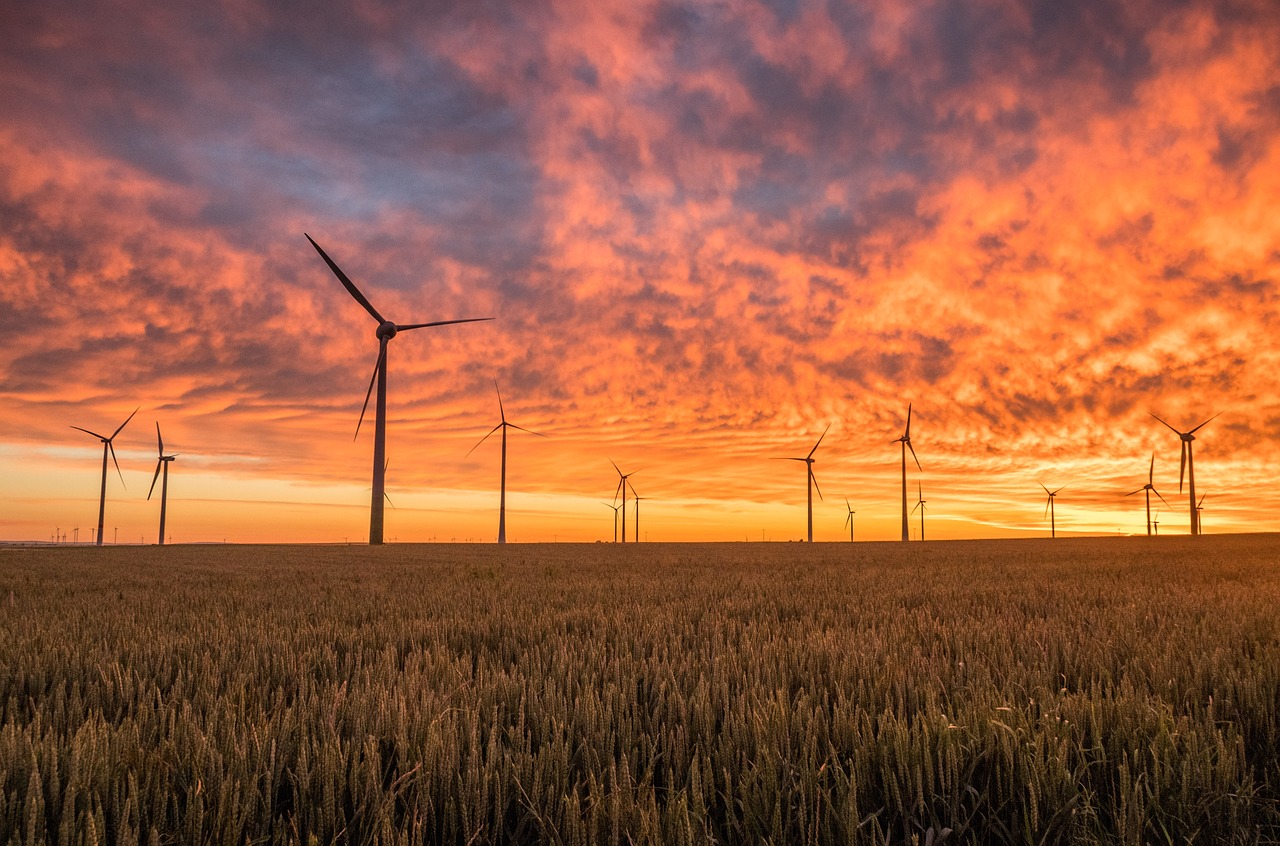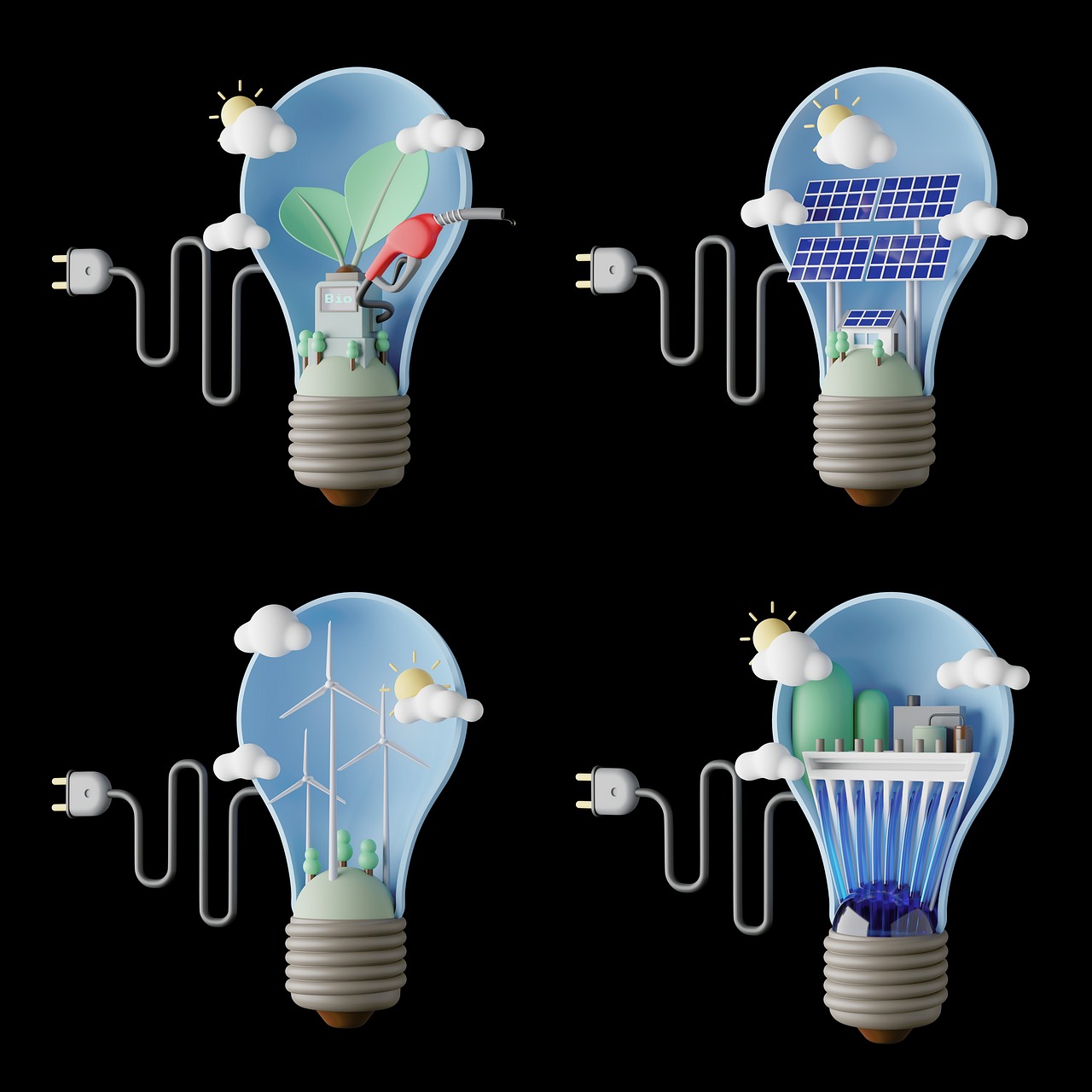The Role of Green Energy in Achieving Sustainable Development
In today's rapidly changing world, the need for sustainable development has never been more pressing. As we face the consequences of climate change, pollution, and dwindling natural resources, the focus on green energy has emerged as a beacon of hope. But what exactly does this mean for our planet and future generations? This article explores how green energy contributes to sustainable development, highlighting its benefits, challenges, and the various forms it takes in addressing environmental issues and promoting economic growth.
Green energy refers to renewable energy sources that are environmentally friendly and sustainable. Unlike fossil fuels, which release harmful emissions into the atmosphere, green energy harnesses the power of natural processes. This includes sources such as solar, wind, hydro, and geothermal energy. The significance of green energy in the context of sustainable development cannot be overstated. It not only provides a cleaner alternative to traditional energy sources but also plays a crucial role in reducing our carbon footprint and preserving our planet for future generations.
Implementing green energy solutions offers numerous advantages that extend beyond just environmental benefits. By transitioning to renewable energy sources, we can achieve a multitude of positive outcomes, including:
- Reduced carbon emissions: Green energy significantly lowers greenhouse gas emissions, which helps combat climate change.
- Improved public health: By reducing air pollution, green energy contributes to better health outcomes for communities.
- Economic growth: The green energy sector is a burgeoning industry that creates new job opportunities and stimulates local economies.
One of the most profound impacts of green energy is its ability to significantly lower greenhouse gas emissions. As we adopt green energy technologies, we witness a positive shift in our environment. By moving away from fossil fuels, we are not just reducing pollution; we are actively participating in a global effort to combat climate change. Imagine a world where clean air and pristine landscapes are the norm rather than the exception. This vision is achievable through the widespread adoption of green energy.
By utilizing renewable sources, individuals and organizations can drastically reduce their carbon footprint. This is crucial in achieving sustainability goals, as every small action contributes to a larger collective effort. Think of it like this: if everyone in a community decided to bike instead of drive just once a week, the cumulative effect would lead to a significant reduction in carbon emissions. It's about making conscious choices that benefit not only ourselves but also the planet.
Green energy promotes the sustainable use of natural resources. By relying on renewable sources, we help conserve ecosystems and biodiversity. For instance, solar panels and wind turbines require far less land and water compared to traditional energy sources. This means that we can harness energy without depleting our planet's precious resources. It’s like choosing to eat from a sustainable farm rather than a factory farm; the former nurtures the land, while the latter often leads to degradation.
Transitioning to green energy is not just an environmental imperative; it also creates new job opportunities and stimulates economic growth. The green energy sector is rapidly expanding, and with it comes a plethora of jobs ranging from engineering to installation and maintenance. As governments and businesses invest in renewable energy projects, they are not only contributing to a sustainable future but also fostering local economies. This dual benefit makes green energy an attractive option for communities worldwide.
Despite its numerous advantages, the transition to green energy is not without challenges. Various obstacles, including technological, financial, and regulatory barriers, can hinder progress. Understanding these challenges is essential for developing effective strategies to overcome them.
The development and integration of new technologies can be slow and costly. Many renewable energy technologies are still in their infancy, and scaling them for widespread use presents significant hurdles. For example, while solar panels have become more efficient, the production and installation processes can still be cumbersome and expensive.
Investing in green energy infrastructure often requires significant capital. Governments and businesses may face financial challenges in making this transition. However, the long-term savings and benefits of green energy can outweigh these initial costs, making it a worthwhile investment for the future.
Government support plays a crucial role in promoting green energy. Various policies and incentives can encourage the adoption of renewable energy sources, making them more accessible and appealing to both consumers and businesses.
Subsidies and tax breaks can significantly lower the cost of green energy projects, making them more attractive to investors. These financial incentives can drive investment in renewable energy projects, paving the way for a cleaner, more sustainable future.
Effective regulatory frameworks are essential for facilitating green energy growth. Supportive legislation can help create a stable environment for renewable energy investments, ensuring that the transition to green energy is not only feasible but also successful.
1. What is green energy?
Green energy refers to renewable energy sources that are environmentally friendly and sustainable, such as solar, wind, and hydro energy.
2. How does green energy benefit the environment?
Green energy significantly reduces greenhouse gas emissions, which helps combat climate change and improves air quality.
3. What are the economic benefits of green energy?
Transitioning to green energy creates new job opportunities and stimulates economic growth, benefiting local communities.
4. What challenges does green energy face?
Challenges include technological barriers, financial constraints, and the need for supportive government policies.

Understanding Green Energy
This article explores how green energy contributes to sustainable development, highlighting its benefits, challenges, and the various forms it takes in addressing environmental issues and promoting economic growth.
Green energy refers to renewable energy sources that are environmentally friendly and sustainable. These energy sources are derived from natural processes that are replenished constantly, making them a viable alternative to fossil fuels. The significance of green energy in the context of sustainable development is immense, as it not only helps mitigate the adverse effects of climate change but also supports economic growth and social equity.
There are several types of green energy, each harnessing the power of nature in unique ways. Some of the most common forms include:
- Solar Energy: Captured from sunlight using solar panels, this energy source is abundant and increasingly affordable.
- Wind Energy: Generated by wind turbines, wind energy is one of the fastest-growing renewable energy sources worldwide.
- Hydropower: Utilizing flowing water to generate electricity, hydropower has been a reliable source of energy for decades.
- Geothermal Energy: This energy harnesses heat from beneath the Earth's surface, providing a consistent and sustainable energy source.
- Biomass Energy: Derived from organic materials, biomass can be converted into electricity, heat, or biofuels, contributing to a circular economy.
The importance of green energy cannot be overstated. As we face the pressing challenges of climate change, dwindling natural resources, and increasing energy demands, green energy offers a pathway to a more sustainable future. It promotes energy independence, reduces reliance on fossil fuels, and fosters innovation in technology and infrastructure.
Moreover, green energy plays a crucial role in achieving the United Nations' Sustainable Development Goals (SDGs). By investing in renewable energy, countries can address multiple goals simultaneously, including poverty eradication, gender equality, and climate action. The transition to green energy is not merely an environmental imperative; it is a comprehensive approach to building resilient communities and economies.
In conclusion, understanding green energy is essential for anyone interested in the future of our planet. It represents a shift towards a more sustainable and equitable energy landscape, where the benefits extend beyond environmental protection to encompass economic and social advancements. As we continue to explore the potential of green energy, it is clear that it holds the key to a sustainable future for generations to come.
What is green energy?
Green energy refers to renewable energy sources that are environmentally friendly and sustainable, including solar, wind, hydropower, geothermal, and biomass energy.
Why is green energy important?
Green energy is crucial for combating climate change, reducing reliance on fossil fuels, promoting energy independence, and supporting economic growth and social equity.
How does green energy contribute to sustainable development?
Green energy contributes to sustainable development by addressing environmental issues, creating job opportunities, and supporting the achievement of the United Nations' Sustainable Development Goals.

Benefits of Green Energy
Implementing green energy solutions offers a plethora of advantages that extend far beyond mere energy production. One of the most compelling benefits is the significant reduction in carbon emissions. By shifting from fossil fuels to renewable sources like solar, wind, and hydroelectric power, we can drastically cut down on the greenhouse gases that contribute to climate change. Imagine a world where the air is cleaner, the skies are bluer, and communities thrive without the looming threat of pollution. This is not just a dream; it can be our reality through the adoption of green energy.
Moreover, the positive impacts of green energy extend into public health. With fewer pollutants in the air, we can expect a decrease in respiratory diseases and other health issues related to poor air quality. Just think about it: less smog means fewer hospital visits and a healthier population. This shift not only improves quality of life but also reduces healthcare costs significantly, allowing funds to be redirected towards other pressing needs.
In addition to environmental and health benefits, green energy is a powerhouse for economic growth. The transition to renewable energy sources has the potential to create millions of jobs across various sectors. From manufacturing solar panels to installing wind turbines, the green energy sector is ripe with opportunities. The table below illustrates some of the key job sectors benefiting from green energy:
| Sector | Job Types | Estimated Job Growth |
|---|---|---|
| Solar Energy | Installers, Engineers, Sales | 20% by 2030 |
| Wind Energy | Turbine Technicians, Engineers, Project Managers | 61% by 2030 |
| Hydropower | Operators, Engineers, Maintenance Workers | 13% by 2030 |
As the demand for renewable energy rises, so does the need for skilled workers in these fields. This shift not only supports job creation but also enhances local economies, providing a sustainable path to prosperity. But the benefits don't stop there. The adoption of green energy technologies also fosters energy independence. By utilizing local resources, countries can reduce their reliance on imported fuels, which often come with fluctuating prices and geopolitical risks. This independence not only strengthens national security but also stabilizes energy costs for consumers.
Lastly, green energy promotes the preservation of our planet's natural resources. By harnessing energy from the sun, wind, and water, we can reduce our dependence on finite resources like coal and oil. This sustainable approach ensures that future generations inherit a planet that is not only livable but thriving. It’s like planting a tree today that will provide shade and fruit for years to come.
In conclusion, the benefits of green energy are multifaceted and far-reaching. From improving public health and creating jobs to fostering economic growth and ensuring environmental sustainability, the transition to renewable energy sources is not just a necessity; it’s an opportunity. So, why wait? The time to embrace green energy is now, and the rewards are waiting to be reaped!
- What is green energy? Green energy refers to renewable energy sources that are environmentally friendly, such as solar, wind, and hydroelectric power.
- How does green energy benefit the environment? It significantly reduces greenhouse gas emissions, helping to combat climate change and preserve natural ecosystems.
- Can green energy create jobs? Yes, the transition to green energy can create millions of jobs in various sectors, from manufacturing to installation and maintenance.
- What are some challenges of implementing green energy? Challenges include technological barriers, financial constraints, and regulatory hurdles that can slow down the transition.

Environmental Impact
When we talk about the of green energy, we're diving into a world of transformation that is not just beneficial but essential for our planet's future. Green energy sources, such as solar, wind, and hydroelectric power, play a pivotal role in reducing greenhouse gas emissions, which are the primary culprits behind climate change. Imagine a world where the air is cleaner, the water is purer, and the natural landscapes are preserved—this is the promise of embracing renewable energy.
The most significant environmental benefit of green energy is its ability to significantly lower greenhouse gas emissions. Traditional energy sources like coal and oil release vast amounts of carbon dioxide and other harmful pollutants into the atmosphere. In contrast, renewable energy sources generate power without emitting these harmful gases. For instance, according to recent studies, switching to wind energy can reduce carbon emissions by up to 90% compared to coal. This shift not only helps in combating climate change but also improves air quality, leading to healthier communities.
Moreover, the adoption of green energy contributes to the preservation of natural resources. By utilizing renewable sources, we can conserve ecosystems and protect biodiversity. The extraction and burning of fossil fuels can lead to habitat destruction, oil spills, and water contamination, which threaten wildlife and plant species. In contrast, renewable energy technologies often have a smaller ecological footprint. For example, solar panels can be installed on rooftops, minimizing land use and avoiding habitat disruption. This sustainable approach allows us to harness energy while safeguarding our precious natural resources.
Another crucial aspect of the environmental impact of green energy is its role in promoting sustainable practices. By investing in renewable energy, we are also investing in technologies that encourage energy efficiency and conservation. Smart grids, for instance, optimize energy use and reduce waste by distributing electricity more effectively. This means that not only are we generating cleaner energy, but we are also using it more wisely, which is a win-win for the environment.
In summary, the environmental impact of green energy is profound and multifaceted. It reduces greenhouse gas emissions, preserves natural resources, and promotes sustainable practices. As we continue to innovate and expand our use of renewable energy, we move closer to a healthier planet. The transition to green energy isn't just an option; it's a necessity for ensuring a sustainable future for generations to come.
- What is green energy? Green energy refers to renewable energy sources that are environmentally friendly and sustainable, such as solar, wind, and hydroelectric power.
- How does green energy help the environment? Green energy significantly reduces greenhouse gas emissions, preserves natural resources, and promotes sustainable practices, leading to a healthier planet.
- What are the economic benefits of transitioning to green energy? Transitioning to green energy creates new job opportunities, stimulates economic growth, and can lead to lower energy costs in the long run.
- What challenges does green energy face? Some challenges include technological barriers, financial constraints, and the need for supportive government policies and incentives.

Reduction of Carbon Footprint
When we talk about reducing our carbon footprint, we're essentially discussing how our choices and actions impact the environment. Think of the carbon footprint as the environmental mark we leave behind, much like a footprint in the sand. The larger the footprint, the greater the impact on our planet. Transitioning to green energy is one of the most effective ways to shrink this footprint, and it’s not just about feeling good; it’s about making a tangible difference.
Green energy sources such as solar, wind, and hydroelectric power produce little to no greenhouse gas emissions. By shifting our reliance from fossil fuels to these renewable sources, we can significantly cut down on the carbon dioxide released into the atmosphere. For instance, consider the following:
| Energy Source | Carbon Emissions (gCO2/kWh) |
|---|---|
| Coal | 1000 |
| Natural Gas | 450 |
| Solar | 50 |
| Wind | 10 |
| Hydroelectric | 5 |
As you can see, the difference in carbon emissions between traditional energy sources and green alternatives is staggering. By embracing technologies like solar panels or wind turbines, individuals and businesses can drastically lower their emissions. This shift not only helps in mitigating climate change but also promotes a healthier environment for future generations.
Moreover, the importance of carbon reduction extends beyond just energy production. It encompasses how we travel, consume goods, and even how we manage waste. For example:
- Transportation: Opting for electric vehicles or public transportation can further reduce carbon emissions.
- Consumption: Supporting local products and sustainable brands minimizes the carbon footprint associated with transportation.
- Waste Management: Practicing recycling and composting lowers the carbon emissions linked to landfills.
Each of these choices contributes to a larger movement towards sustainability. By making conscious decisions in our daily lives, we not only reduce our carbon footprint but also inspire others to do the same. It’s like throwing a pebble into a pond; the ripples of our actions can spread far and wide, encouraging a collective effort towards a greener planet.
In conclusion, reducing our carbon footprint through green energy and sustainable practices is not just a trend; it’s a necessity. As we face the realities of climate change, every step we take towards minimizing our environmental impact counts. Let’s embrace this challenge and work together to create a sustainable future.
Q: What is a carbon footprint?
A: A carbon footprint is the total amount of greenhouse gases, primarily carbon dioxide, that are emitted directly or indirectly by an individual, organization, event, or product.
Q: How can I reduce my carbon footprint?
A: You can reduce your carbon footprint by using green energy sources, driving less, recycling, consuming less, and supporting sustainable practices.
Q: Why is reducing carbon emissions important?
A: Reducing carbon emissions is crucial for combating climate change, improving air quality, and creating a healthier environment for current and future generations.

Preservation of Natural Resources
In today's world, where the **depletion of natural resources** is a pressing concern, the role of green energy in preserving these invaluable assets cannot be overstated. Green energy, derived from renewable sources such as solar, wind, and hydro, promotes a sustainable approach to energy consumption that significantly reduces the pressure on our planet's finite resources. By harnessing these renewable sources, we not only **mitigate the impacts of climate change** but also ensure that future generations can enjoy a healthy and vibrant ecosystem.
One of the key benefits of green energy is its ability to **conserve ecosystems** and enhance biodiversity. Traditional energy sources, like fossil fuels, often lead to habitat destruction, pollution, and resource depletion. In contrast, renewable energy projects tend to have a much lower environmental footprint. For instance, solar farms can be constructed on previously disturbed lands, while wind turbines can be placed in areas that do not disrupt local wildlife. This thoughtful placement helps to preserve the natural habitats of countless species, allowing ecosystems to thrive.
Moreover, adopting green energy practices encourages the **sustainable management of natural resources**. For example, utilizing biomass for energy production can lead to better forest management practices. Instead of clear-cutting forests for timber, sustainable forestry practices can be implemented, where only certain trees are harvested, allowing the forest to regenerate naturally. This not only provides a continuous source of biomass energy but also maintains the ecological balance of the forest.
In addition to conserving ecosystems, green energy initiatives can also promote water conservation. Traditional energy production methods, particularly fossil fuel extraction and coal-fired power plants, require extensive water resources for cooling and processing. On the other hand, renewable energy sources like solar and wind require minimal water, reducing the strain on our already stressed water supplies. This shift towards greener energy solutions is crucial, especially in regions facing water scarcity.
Furthermore, the transition to green energy can lead to a more **circular economy**, where resources are reused and recycled rather than wasted. For example, the production of solar panels and wind turbines often incorporates recycled materials, minimizing waste and reducing the need for new raw materials. This approach not only preserves natural resources but also promotes innovation in material science and engineering.
In summary, the preservation of natural resources through green energy is not just a **benefit**; it is a necessity for achieving long-term sustainability. By investing in renewable energy technologies, we can significantly reduce our ecological footprint, conserve vital ecosystems, and promote a healthier planet for all living beings. The transition to green energy is a journey worth taking, as it paves the way for a sustainable future that respects and cherishes our natural resources.
- What are the main types of green energy? Green energy primarily includes solar, wind, hydroelectric, geothermal, and biomass energy.
- How does green energy help in preserving natural resources? Green energy reduces reliance on fossil fuels, conserves ecosystems, and promotes sustainable resource management.
- Can green energy sources fully replace fossil fuels? While green energy has the potential to significantly reduce fossil fuel dependence, a balanced approach that includes energy efficiency and conservation is essential.
- What role do governments play in promoting green energy? Governments can provide subsidies, tax incentives, and establish regulatory frameworks to encourage the adoption of green energy technologies.

Economic Opportunities
The transition to green energy is not just a step towards environmental sustainability; it is also a catalyst for economic growth. As we shift from traditional energy sources to renewable ones, we open the door to a myriad of economic opportunities that can benefit individuals, businesses, and entire communities. Imagine a world where the energy sector not only powers our homes and industries but also fuels job creation and innovation. This is the promise of green energy.
One of the most significant advantages of investing in green energy is the creation of new jobs. The renewable energy sector is rapidly expanding, and with it comes a demand for skilled labor. According to recent studies, the global renewable energy sector employed over 11 million people in 2018, and that number is expected to grow exponentially. These jobs span various fields, including manufacturing, installation, maintenance, and research and development. For instance, solar panel installation alone has become one of the fastest-growing job categories in many regions, providing opportunities for workers with diverse skill sets.
Moreover, green energy initiatives can stimulate local economies. When communities invest in renewable energy projects, they often see a boost in local business activity. For example, the construction of wind farms or solar energy facilities requires materials, services, and labor, which can lead to increased demand for local suppliers and contractors. This ripple effect can enhance economic resilience, especially in rural areas where job opportunities may be limited.
Additionally, the green energy sector promotes innovation. As companies strive to develop more efficient technologies and sustainable practices, they often invest in research and development. This not only leads to technological advancements but also positions countries as leaders in the global green economy. For instance, countries that prioritize renewable energy research are likely to attract international investments, further solidifying their economic standing.
However, to fully harness these economic opportunities, it is essential to address some challenges. The initial investment in green technologies can be high, which may deter businesses from making the switch. But with the right government policies and incentives, such as subsidies and tax breaks, the financial barriers can be significantly reduced. By creating a supportive environment for green energy investments, governments can catalyze economic growth while also addressing climate change.
In summary, the economic opportunities presented by green energy are vast and varied. From job creation to local economic stimulation and innovation, the benefits extend beyond environmental sustainability. As we continue to embrace renewable energy, we are not just investing in a cleaner planet; we are also investing in a brighter economic future for all.
- What types of jobs are created by the green energy sector?
Jobs in the green energy sector include roles in manufacturing, installation, maintenance, and research and development of renewable energy technologies. - How does green energy stimulate local economies?
Investing in renewable energy projects increases demand for local materials and services, leading to job creation and economic growth in communities. - What are some challenges to transitioning to green energy?
Challenges include high initial investments, technological barriers, and the need for supportive government policies. - How can governments encourage green energy investments?
Governments can implement subsidies, tax incentives, and create favorable regulatory frameworks to promote the adoption of renewable energy sources.

Challenges in Implementing Green Energy
Transitioning to green energy is like embarking on a thrilling adventure, but just like any great journey, it comes with its own set of challenges. While the benefits of renewable energy sources are clear, the road to widespread adoption is often bumpy. There are several hurdles that need to be overcome, and understanding these challenges is crucial for anyone interested in the future of our planet.
One of the most significant obstacles is the technological barrier. Developing new green technologies is not only time-consuming but also requires substantial investment. For instance, while solar panels and wind turbines have become more efficient over time, the research and development needed to improve these technologies further can be slow. Moreover, integrating these technologies into existing energy systems can pose logistical challenges. It's akin to trying to fit a square peg into a round hole; the existing infrastructure often isn't designed to accommodate the innovations of the green energy sector.
Another major hurdle is financial constraints. Transitioning to green energy often requires hefty upfront investments. Governments and businesses may find it daunting to allocate the necessary capital for renewable energy infrastructure. This financial burden can deter potential investors who might be wary of the long payback periods associated with such investments. For example, while the long-term savings from green energy are substantial, the initial costs can be a significant deterrent. It's like wanting to buy a house: the long-term benefits are clear, but the down payment can feel overwhelming.
Additionally, regulatory barriers can complicate the transition to green energy. In many regions, outdated regulations may not support the integration of renewable energy sources. This can lead to a situation where the rules of the game don't align with the goals of sustainability. For instance, some policies may favor fossil fuels over renewable sources, making it difficult for green energy projects to compete. It's essential for policymakers to recognize these discrepancies and update regulations to facilitate the growth of green technologies.
Despite these challenges, the momentum for green energy is building. Governments and organizations are increasingly aware of the need for sustainable practices, and many are taking steps to address these barriers. For example, some countries have introduced ambitious renewable energy targets, while others have implemented programs to support research and innovation in green technologies. By fostering collaboration between governments, businesses, and communities, we can pave the way for a greener future.
In summary, while the challenges of implementing green energy are significant, they are not insurmountable. By investing in technology, addressing financial constraints, and reforming regulatory frameworks, we can overcome these obstacles and unlock the full potential of renewable energy. The journey towards a sustainable future may be challenging, but the rewards of cleaner air, a healthier planet, and economic growth are well worth the effort.
- What are the main challenges in implementing green energy?
The main challenges include technological barriers, financial constraints, and regulatory issues that can hinder the adoption of renewable energy sources. - How can governments support green energy initiatives?
Governments can support green energy through subsidies, tax incentives, and creating regulatory frameworks that encourage investment in renewable energy projects. - What role do individuals play in promoting green energy?
Individuals can contribute by advocating for renewable energy policies, investing in green technologies, and reducing their own carbon footprints.

Technological Barriers
Transitioning to green energy is not just about flipping a switch; it involves navigating a complex landscape of . One of the primary challenges is the development and integration of renewable energy technologies, which can often be slow and costly. Imagine trying to assemble a jigsaw puzzle with missing pieces; that’s how the renewable energy sector feels when it comes to technology. Various renewable sources like solar, wind, and hydroelectric power require advanced technology to harness their full potential. However, many regions still lack the necessary infrastructure to support these innovations.
Moreover, there’s the issue of energy storage. Renewable energy sources, particularly solar and wind, are dependent on environmental conditions. When the sun isn’t shining or the wind isn’t blowing, energy production can drop significantly. This inconsistency raises the need for efficient energy storage systems, such as batteries, which are still in their developmental stages. The current battery technology is not only expensive but also has limitations in terms of capacity and lifespan. This creates a significant hurdle for communities looking to rely on renewable energy as their primary source.
Another critical barrier is the interconnection with existing energy grids. Many countries have outdated grid systems that are not equipped to handle the influx of renewable energy. Upgrading these grids requires substantial investment and time, which can delay the transition to greener sources. In some cases, local regulations can further complicate the integration process, making it harder for new technologies to be adopted.
Lastly, the skill gap in the workforce cannot be overlooked. The green energy sector requires a skilled labor force adept in new technologies and systems. Unfortunately, many workers are still trained in traditional energy practices, leaving a void in expertise that needs to be filled. To address this, educational programs and vocational training must evolve to prepare the workforce for the demands of this rapidly changing field.
In summary, while the potential of green energy is immense, the path to widespread adoption is fraught with technological barriers. From the need for advanced energy storage solutions to outdated grid systems and a skilled workforce, these challenges must be addressed to realize the full benefits of renewable energy. The journey may be daunting, but overcoming these obstacles is essential for a sustainable future.
- What are the main technological barriers to green energy? The main barriers include the development and integration of new technologies, energy storage challenges, outdated grid systems, and a skill gap in the workforce.
- Why is energy storage important for renewable energy? Energy storage is crucial because renewable sources like solar and wind are intermittent; efficient storage systems help manage energy supply and demand.
- How can we overcome these technological barriers? Overcoming these barriers requires investment in research and development, upgrading infrastructure, and enhancing training programs for the workforce.

Financial Constraints
Transitioning to green energy is not just a noble endeavor; it’s also a significant financial undertaking. While the benefits of renewable energy sources are clear, the initial investment required to develop and implement these technologies can be daunting for many governments and businesses. Imagine trying to build a beautiful house on a foundation that requires a hefty sum before you even lay the first brick. In the world of green energy, those bricks are the advanced technologies and infrastructures needed to harness renewable resources effectively.
One of the primary financial barriers is the high upfront costs associated with renewable energy projects. For instance, solar panels, wind turbines, and geothermal systems often require substantial capital investment before they start generating returns. This can be particularly challenging for smaller businesses or developing countries that may lack access to the necessary funds. Moreover, the return on investment (ROI) can take years, making it hard for investors to commit their resources when immediate financial returns are not guaranteed.
Additionally, the financial landscape for green energy is often complicated by fluctuating market conditions and the availability of financing options. Traditional financial institutions may be hesitant to provide loans for renewable energy projects due to perceived risks or lack of familiarity with the technology. This creates a vicious cycle where limited funding options hinder the growth of green energy initiatives, which in turn limits the market's understanding and acceptance of these technologies.
To illustrate the financial constraints faced by the green energy sector, consider the following table showcasing the estimated costs of various renewable energy sources:
| Energy Source | Estimated Initial Investment (per MW) | Average Payback Period |
|---|---|---|
| Solar Power | $1,000,000 | 5-7 years |
| Wind Power | $1,500,000 | 6-10 years |
| Geothermal Energy | $2,500,000 | 5-8 years |
| Hydropower | $5,000,000 | 8-12 years |
As you can see, the financial commitment required for these projects is significant, and the payback periods can be lengthy. This can deter investors who are looking for quicker returns, making it crucial for governments and policymakers to step in with supportive financial frameworks.
Ultimately, addressing these financial constraints is essential for the successful transition to green energy. By providing subsidies, grants, and low-interest loans, governments can incentivize investment in renewable energy projects. Additionally, fostering partnerships between public and private sectors can help mitigate risks and share the financial burden, ensuring that the shift towards a sustainable energy future is both attainable and economically viable.
- What are the main financial challenges in transitioning to green energy? The main challenges include high upfront costs, limited access to financing, and lengthy payback periods.
- How can governments support green energy initiatives financially? Governments can provide subsidies, grants, and low-interest loans to incentivize investment in renewable energy projects.
- Why is it difficult for small businesses to invest in green energy? Small businesses often lack the capital needed for initial investments and may have limited access to financing options.

Government Policies and Incentives
Government support plays a crucial role in promoting green energy. Without the backing of effective policies and incentives, the transition to renewable energy sources can be slow and cumbersome. Governments around the world are recognizing the importance of fostering a sustainable future, and they are implementing various measures to encourage the adoption of green energy technologies. These initiatives not only aim to reduce dependence on fossil fuels but also to create a more resilient economy.
One of the most effective methods to stimulate green energy investment is through subsidies and tax incentives. By providing financial support, governments can lower the initial costs associated with renewable energy projects, making them more attractive to businesses and individuals alike. For instance, many countries offer tax credits for solar panel installations, which can significantly reduce the overall expenditure for homeowners looking to harness solar power. Additionally, subsidies can be directed towards research and development in the green energy sector, paving the way for innovative technologies that could revolutionize energy consumption.
Moreover, the establishment of regulatory frameworks is essential for the successful implementation of green energy policies. These frameworks create a structured environment where renewable energy projects can flourish. For example, feed-in tariffs guarantee a fixed price for energy generated from renewable sources, ensuring that producers receive fair compensation for their contributions to the energy grid. This not only encourages investment but also stabilizes the market for green energy.
| Policy Type | Description | Impact |
|---|---|---|
| Subsidies | Financial support for renewable energy projects. | Increases investment and lowers costs for consumers. |
| Tax Incentives | Tax breaks for individuals and companies using renewable energy. | Encourages adoption and reduces financial burden. |
| Feed-in Tariffs | Guaranteed payment for energy producers. | Stabilizes income for renewable energy providers. |
In addition to these measures, governments can also promote public awareness campaigns aimed at educating citizens about the benefits of green energy. By fostering a culture of sustainability, these campaigns encourage individuals to make environmentally conscious choices, such as using energy-efficient appliances or opting for renewable energy sources. When the public is informed and engaged, the push for green energy becomes a collective effort, amplifying its impact.
However, it’s important to note that the effectiveness of these policies often depends on their implementation and the political will behind them. In some regions, bureaucratic hurdles and lack of coordination among agencies can hinder progress. Therefore, continuous evaluation and adaptation of policies are necessary to ensure they meet the evolving needs of the energy market.
In summary, government policies and incentives are pivotal in the transition to green energy. By offering financial support, establishing regulatory frameworks, and promoting public awareness, governments can create an environment conducive to sustainable development. It is this proactive approach that will help mitigate climate change and foster economic growth, ultimately leading to a greener planet for future generations.
- What are the main types of government incentives for green energy?
Government incentives include subsidies, tax credits, and feed-in tariffs, which aim to reduce costs and promote investment in renewable energy projects. - How do regulatory frameworks support green energy?
Regulatory frameworks provide a structured environment that encourages investment and ensures fair compensation for renewable energy producers. - Why is public awareness important in promoting green energy?
Public awareness drives community engagement and encourages individuals to make sustainable choices, amplifying the impact of green energy initiatives.

Subsidies and Tax Incentives
Subsidies and tax incentives play a crucial role in making green energy solutions more accessible and appealing to both consumers and businesses. Imagine a world where solar panels and wind turbines are not just dreams but a reality for everyone. This is where government support comes into play, acting as a catalyst for the transition to renewable energy sources. By offering financial assistance, governments can significantly reduce the initial costs associated with setting up renewable energy systems, making it easier for individuals and organizations to invest in sustainable practices.
For instance, many countries provide subsidies that directly lower the price of renewable energy technologies. These subsidies can cover a portion of the installation costs for solar panels or wind turbines, thereby encouraging more homeowners and businesses to adopt these technologies. Additionally, tax incentives such as credits and deductions further sweeten the deal. These financial perks can lead to substantial savings, making green energy not just an environmentally friendly choice but also a financially savvy one.
| Type of Incentive | Description | Example |
|---|---|---|
| Investment Tax Credit (ITC) | A tax credit for a percentage of the cost of solar systems. | 30% tax credit for residential solar installations in the U.S. |
| Production Tax Credit (PTC) | A tax credit for the production of renewable energy. | Wind energy producers receive a credit per kilowatt-hour generated. |
| Cash Grants | Direct payments to offset installation costs. | Grants for installing energy-efficient appliances. |
Moreover, these incentives can also stimulate local economies by creating jobs in the renewable energy sector. When people see that there are financial benefits to going green, they are more likely to invest in these technologies, leading to a ripple effect of economic growth. This not only helps the environment but also boosts local job markets, as new positions are created in manufacturing, installation, and maintenance of renewable energy systems.
However, it’s essential to recognize that the effectiveness of these subsidies and tax incentives can vary widely depending on the region and the specific policies in place. Some areas may offer more generous incentives than others, which can lead to disparities in the adoption of green energy technologies. Thus, it’s critical for governments to continually assess and adjust their policies to ensure they are effectively promoting sustainable development.
In conclusion, subsidies and tax incentives are vital tools in the transition to green energy. They not only make renewable energy more accessible but also drive economic growth and job creation. As we move forward in our quest for sustainability, it’s imperative that these financial supports remain robust and adaptable to meet the ever-changing landscape of energy needs.
- What are the main types of subsidies for green energy? Subsidies can include direct cash grants, tax credits, and rebates for renewable energy installations.
- How do tax incentives benefit consumers? Tax incentives lower the overall cost of renewable energy systems, making them more affordable for consumers.
- Can subsidies lead to job creation? Yes, subsidies can stimulate the green energy sector, leading to new job opportunities in various fields.
- Are subsidies available worldwide? Availability varies by country and region; some places offer extensive incentives while others may have limited support.

Regulatory Frameworks
When it comes to promoting green energy, play an essential role. These frameworks are like the backbone of a sustainable energy system, providing the necessary structure and guidelines for both governments and businesses to thrive in the renewable energy sector. Without effective regulations, the transition to green energy could face significant hurdles, much like trying to build a house without a solid foundation.
One of the primary functions of regulatory frameworks is to create a stable environment for investment. Investors are more likely to commit their resources when they see clear, consistent regulations that support renewable energy initiatives. This includes everything from permitting processes to standards for energy production and consumption. By establishing these guidelines, governments can reduce uncertainty, making it easier for companies to plan long-term projects.
Moreover, regulatory frameworks often include incentives that encourage the adoption of green technologies. For instance, many countries have implemented laws that mandate a certain percentage of energy must come from renewable sources, effectively pushing companies to innovate and invest in cleaner technologies. These regulations can also include feed-in tariffs or renewable portfolio standards, which ensure that green energy producers receive fair compensation for their contributions to the grid.
However, crafting these regulations is not without its challenges. Policymakers must balance the need for environmental protection with economic growth. This can lead to complex legislation that sometimes becomes a barrier rather than a facilitator. For example, overly stringent regulations can stifle innovation and discourage investment, while too lenient ones can fail to deliver the environmental benefits we desperately need. Therefore, it’s crucial for governments to engage in ongoing dialogue with stakeholders, including businesses, environmental groups, and the public, to create frameworks that are effective and equitable.
In addition to national regulations, local governments also play a pivotal role in implementing green energy policies. They can tailor regulations to fit their specific needs, which can lead to innovative solutions that might not be feasible at a national level. For example, cities can introduce zoning laws that facilitate the installation of solar panels on residential buildings or create incentives for energy-efficient buildings. This localized approach can be incredibly effective in driving the green energy movement forward.
To summarize, the importance of robust regulatory frameworks cannot be overstated. They serve as the guiding principles that enable the growth of green energy, driving investments, fostering innovation, and ensuring that environmental goals are met. As we move towards a more sustainable future, it is essential for governments to continuously refine these frameworks to adapt to emerging technologies and changing market conditions.
- What are regulatory frameworks? Regulatory frameworks are sets of rules and guidelines established by governments to facilitate the growth of specific sectors, such as green energy.
- How do these frameworks promote green energy? They create a stable investment environment, provide incentives for renewable energy adoption, and ensure compliance with environmental goals.
- Why is stakeholder engagement important? Engaging stakeholders helps create balanced regulations that address the needs of the environment, businesses, and the public.
- Can local governments influence green energy policies? Yes, local governments can implement tailored regulations that cater to their unique circumstances, driving innovation and progress in green energy.
Frequently Asked Questions
- What is green energy?
Green energy refers to energy derived from renewable sources that are environmentally friendly. This includes solar, wind, hydroelectric, and geothermal energy, all of which contribute to reducing our carbon footprint and promoting sustainable development.
- How does green energy benefit the environment?
Green energy significantly reduces greenhouse gas emissions, which are a major contributor to climate change. By transitioning to renewable energy sources, we can lower air pollution, conserve natural resources, and protect ecosystems, ultimately leading to a healthier planet.
- What economic opportunities does green energy create?
The shift to green energy opens up a wealth of job opportunities in various sectors, including manufacturing, installation, and maintenance of renewable energy technologies. This transition not only stimulates economic growth but also fosters innovation and investment in sustainable practices.
- What challenges are associated with implementing green energy?
While green energy has many benefits, challenges such as technological barriers, financial constraints, and regulatory hurdles can slow down its adoption. Developing new technologies can be costly, and securing funding for renewable projects often requires significant investment.
- How can government policies support green energy?
Governments can play a crucial role in promoting green energy through subsidies, tax incentives, and supportive regulatory frameworks. These policies can lower the financial barriers for businesses and individuals, making it easier to invest in renewable energy solutions.
- What are some examples of government incentives for green energy?
Examples of government incentives include tax credits for solar panel installations, grants for energy efficiency upgrades, and feed-in tariffs that guarantee a fixed price for electricity generated from renewable sources. These incentives help encourage the adoption of green technologies.



















